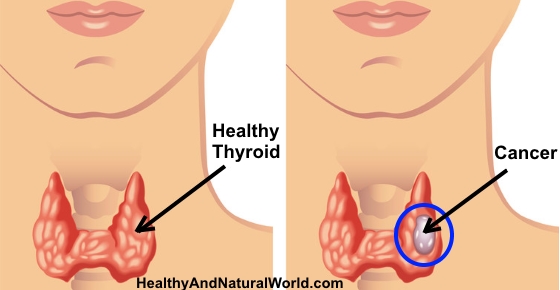1 Minute At Home Thyroid Self-Test

Thyroid cancer is a disease that you get when abnormal cells begin to grow in your thyroid gland and it is much more common in women than in man. Read on to learn about your thyroid gland and how to do a thyroid self-check to detect suspicions lumps (which may indicate thyroid cancer).
The Thyroid Gland
The thyroid is a gland shaped like a butterfly and located in the front of your neck.
The thyroid has a very important role in our body and secretes several hormones called thyroxine (T4) and triiodothyronine (T3). These hormones regulate the body’s metabolism, growth and development and body temperature. They also regulate heart and digestive function, muscle control, brain development and bone maintenance. The brain’s pituitary gland controls the activity of your thyroid gland by secreting TSH (thyroid stimulating hormone).
According to the American Thyroid Association more than 12% of the U.S. population will develop a thyroid condition during their lifetime, and these are many millions of people. It is estimated that as many as 15 million people in the U.S. alone are suffering from some form of thyroid disorder.
I’ve written a number of articles about the thyroid gland and I covered subjects such as:
- The Most Common Thyroid Disorders
- How to Test Your Thyroid With a Thermometer
- The top 13 signs that you have a thyroid disorder
- Low TSH: Causes, Symptoms, and How it Affects T3 and T4
- High TSH: Causes, Symptoms, and How it Affects T3 and T4
This article is all about thyroid cancer and on how to do a thyroid self test for to detect an unusual growth of your thyroid.
Thyroid Cancer
Thyroid cancer, although certainly a serious health condition, is usually easy to detect and to treat when diagnosed early on.
According to statistics released by the American Cancer Society, more than 60,000 thyroid cancer diagnoses were made in the United States in 2015, and 1,950 deaths have been attributed to thyroid cancer. Although these numbers may be jarring, thyroid cancer remains one of the least lethal types of cancer, with the death rate remaining fairly steady over time in spite of the recent uptick in diagnoses.2
There are 4 main types of thyroid cancer, and some are more common than others.
Thyroid cancer type and incidence:
- Papillary and/or mixed papillary/follicular thyroid cancer: ~ 80%
- Follicular and/or Hurthle cell thyroid cancer: ~ 15%
- Medullary thyroid cancer: ~ 3%
- Anaplastic thyroid cancer: ~ 2%
Thyroid cancer diagnoses are on the rise, mostly due to modern technological advances making early diagnosis easier for clinicians.
You need to know the symptoms and risk factors of thyroid cancer so you can be watchful and proactive in maintaining your own thyroid gland’s health.3
Symptoms of Thyroid Cancer
Be on the lookout for the following symptoms, as they may indicate the presence of a thyroid tumor:
- Lumps in the neck, sometimes painful
- Soreness in the neck, potentially radiating up to the ears
- Difficulty swallowing or breathing
- A chronically raspy or hoarse voice
- Coughing not due to sickness or other causes like smoking
Thyroid Cancer – Risk factors
If you have any of the following risk factors, you may want to remain especially vigilant about potential symptoms of thyroid cancer4:
- Female gender (women get thyroid cancer more often than men)
- Age – Thyroid cancer can occur in any age group, although it is most common after age 30, and its aggressiveness increases significantly in older patients
- Radiation exposure, especially to the neck and torso areas (may occur due to X-ray scanning prior to enhanced safety measures, radiation treatments in the 1950s and before, or due to a nuclear accident)
- Genetics and family history of thyroid cancer
Thyroid Cancer – At Home Self Check
To check your thyroid for unusual growths—benign or cancerous—all you’ll need is a cup of water and a mirror that allows you a good view of your neck. Please read the written explanation below and make sure to watch the two minute video which is at the bottom of the post (the video demonstrates the self check).
Step #1: Get a cup of water and a mirror
Fill a cup with water and stand in front of a well-lit mirror that offers a good view of your entire throat, from collarbone to chin. Know the area you will be checking—your thyroid rests above your collarbone and “hugs” your throat in the shape of a small butterfly, just below the larynx, right around the bottom one-third of your throat.
Step #2: Take a sip and take a look
Take a sip of water and tilt your head back with your chin up, and keep an eye on your throat and neck as you swallow.
You may need to do this several times to get a good look at your neck as you swallow—keeping your chin up and your eyes down on the mirror can be a bit tricky at first.
Watch the thyroid area as you swallow, looking for any bulges near the area where your thyroid gland would be. Is the area symmetrical as you swallow, or is there a difference between the sides.
What to Do Next
If there is asymmetry between sides or any out-of-place bumps near your thyroid gland that become apparent when you swallow, you need to discuss your findings with a doctor. An endocrinologist specializes in evaluating and treating glands like the thyroid and would be able to confirm whether or not you have thyroid cancer or another thyroid disorder.
Here is a short video with a demonstration of the thyroid self check:
Read these related posts:
1. Top 13 Signs of a Thyroid Disorder
2. Maintain Your Thyroid in Top Condition with This Juice
Resources:
(1) http://www.endocrineweb.com/endocrinology/overview-thyroid
(2) http://www.cancer.org/cancer/thyroidcancer/detailedguide/thyroid-cancer-key-statistics
(3) http://www.cancer.org/cancer/thyroidcancer/detailedguide/thyroid-cancer-signs-symptoms
(4) http://www.mayoclinic.org/diseases-conditions/thyroid-cancer/basics/risk-factors/con-20043551
(5) http://www.webmd.com/cancer/tc/thyroid-cancer-what-increases-your-risk
(6) http://www.endocrineweb.com/conditions/thyroid-nodules/common-thyroid-disorders-thyroid-self-examination
(2) http://www.cancer.org/cancer/thyroidcancer/detailedguide/thyroid-cancer-key-statistics
(3) http://www.cancer.org/cancer/thyroidcancer/detailedguide/thyroid-cancer-signs-symptoms
(4) http://www.mayoclinic.org/diseases-conditions/thyroid-cancer/basics/risk-factors/con-20043551
(5) http://www.webmd.com/cancer/tc/thyroid-cancer-what-increases-your-risk
(6) http://www.endocrineweb.com/conditions/thyroid-nodules/common-thyroid-disorders-thyroid-self-examination
